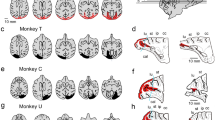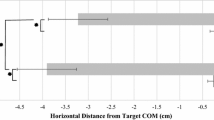Abstract
Fourteen patients with a chronic, unilateral lesion restricted to the frontal lobe (twelve involving the frontal eye field (FEF)), nine patients with a chronic, unilateral lesion restricted to posterior association cortex (eight involving the intraparietal sulcus (IPS)), and twelve neurologically normal control subjects were studied in an anti-saccade task. A combination of manipulating cuing and fixation offset enabled us to examine the effects of chronic oculomotor lesions on both saccade preparation and voluntary control over ocular fixation. Patients with lesions of the FEF made more errors (reflexive glances) toward contralesional targets, whereas patients with IPS lesions made fewer errors toward contralesional targets. Patients with IPS lesions had increased latencies to initiate saccades away from contralesional targets. For FEF patients, the presence of a fixation point inhibited the initiation of contralesionally directed saccades less than those directed ipsilesionally. Saccade preparation in response to a cue did not reduce the inhibitory effect of a fixation point on initiating anti-saccades directed either ipsilesionally or contralesionally for either patient group. We conclude that chronic IPS lesions result in a reduced contralesional visual grasp reflex (VGR) and delayed utilization of visual signals in the contralesional field for planning voluntary eye movements. In contrast, patients with chronic FEF lesions are impaired in inhibiting the VGR toward contralesional signals, and manifest an asymmetry in the balance between fixation and saccade activity. Moreover, voluntary control of fixation is compromised after chronic damage to either frontal or parietal oculomotor cortex.




Similar content being viewed by others
References
Blanke O, Morand S, Thut G, Michel CM, Spinelli L, Landis T, Seeck M (1999) Visual activity in the human frontal eye field. Neuroreport 10:925–930
Burman DD, Bruce CJ (1997) Suppression of task-related saccades by electrical stimulation in the primate’s frontal eye field. J Neurophysiol 77:2252–2267
Butter CM, Rapcsak SZ, Watson RT, Heilman KM (1988) Changes in sensory inattention, directional motor neglect, and “release” of the fixation reflex following a unilateral frontal lesion: a case report. Neuropsychologia 26:533–545
Deuel RK, Collins RC (1984) The functional anatomy of frontal lobe neglect in monkeys: behavioral and 2-deoxyglucose studies. Ann Neurol 15:521–529
Dias EC, Bruce CJ (1994) Physiological correlate of fixation disengagement in the primate’s frontal eye field. J Neurophysiol 72:2532–2537
Dorris MC, Pare M, Munoz DP (1997) Neuronal activity in monkey superior colliculus related to the initiation of saccadic eye movements. J Neurosci 17:8566–8579
Godoy J, Lüders H, Dinner DS, Morris HH, Wyllie E (1990) Versive eye movements elicited by cortical stimulation of the human brain. Neurology 40:296–299
Gold JI, Mazurek ME (2002) Posterior parietal cortex: not just where, but how. Nat Neurosci 5:506–508
Gottlieb J, Goldberg ME (1999) Activity of neurons in the lateral intraparietal area of the monkey during an anti-saccade task. Nat Neurosci 2:906–912
Hanes DP, Patterson WF 2nd, Schall JD (1998) Role of frontal eye fields in countermanding saccades: visual, movement, and fixation activity. J Neurophysiol 79:817–834
Henik A, Rafal R, Rhodes D (1994) Endogenously generated and visually guided saccades after lesions of the human frontal eye fields. J Cogn Neurosci 6:400–411
Hikosaka O, Wurtz RH (1989) The basal ganglia. In: Wurtz RH, Goldberg ME (eds) The neurobiology of saccadic eye movements. Elsevier Science Publishers BV, Amsterdam, pp 257–282
Huerta MF, Krubitzer LA, Kaas JH (1986) Frontal eye field as defined by intracortical microstimulation in Squirrel monkeys, Owl monkeys, and Macaque monkeys: I. Subcortical connections. J Comp Neurol 253:415–439
Kwon SE, Heilman K (1991) Ipsilateral neglect in a patient following a unilateral frontal lesion. Neurology 41:2001–2004
Lüders H, Lesser RP, Dinner DS, Morris HH, Wyllie E, Godoy J (1988) Localization of cortical function: new information from extraoperative monitoring of patients with epilepsy [published erratum appears in Epilepsia 29:828]. Epilepsia 29[Suppl 2]: S56–S65
Machado L, Rafal RD (1997) The effects of saccade preparation on the fixation offset effect in patients with frontal eye field lesions. Paper presented at the Society for Neuroscience, New Orleans, Louisiana
Machado L, Rafal RD (2000) Strategic control over saccadic eye movements: studies of the fixation offset effect. Percept Psychophys 62:1236–1242
Machado L, Rafal RD (2004) Control of fixation and saccades in humans with chronic lesions of oculomotor cortex. Neuropsychology (in press)
Munoz DP, Istvan PJ (1998) Lateral inhibitory interactions in the intermediate layers of the monkey superior colliculus. J Neurophysiol 79:1193–1209
Munoz DP, Wurtz RH (1992) Role of the rostral superior colliculus in active visual fixation and execution of express saccades. J Neurophysiol 67:1000–1002
Munoz DP, Wurtz RH (1993) Fixation cells in monkey superior colliculus. I. Characteristics of cell discharge. J Neurophysiol 70:559–575
Paus T (1996) Location and function of the human frontal eye-field: a selective review. Neuropsychologia 34:475–483
Posner MI, Walker JA, Friedrich FJ, Rafal RD (1987) How do the parietal lobes direct covert attention? Neuropsychologia 25:135–146
Rafal R, Machado L, Ro T, Ingle H (2000) Looking forward to looking: saccade preparation and control of the visual grasp reflex. In: Monsell S, Driver J (eds) Control of cognitive processes: attention and performance XVIII. MIT Press, Cambridge, MA, pp 155–174
Ro T, Cheifet S, Ingle H, Shoup R, Rafal R (1999) Localization of the human frontal eye fields and motor hand area with transcranial magnetic stimulation and magnetic resonance imaging. Neuropsychologia 37:225–231
Ro T, Rorden C, Driver J, Rafal R (2001) Ipsilesional biases in saccades but not perception after lesions of the human inferior parietal lobule. J Cogn Neurosci 13:920–929
Saslow MG (1967) Effects of components of displacement-step stimuli upon latency for saccadic eye movements. J Opt Soc Am 57:1024–1029
Schiller PH, True SD, Conway JL (1980) Deficits in eye movements following frontal eye-field and superior colliculus ablations. J Neurophysiol 44:1175–1189
Segraves MA, Goldberg ME (1987) Functional properties of corticotectal neurons in the monkey’s frontal eye field. J Neurophysiol 58:1387–1419
Sprague JM (1966) Interaction of cortex and superior colliculus in mediation of peripherally summoned behavior in the cat. Science 153:1544–1547
Acknowledgements
Supported by PHS grants RO1 MH41544 and RO1 MH51400 to Robert Rafal. Special thanks to Harris Ingle and Ilya Bushev for helping with data collection and to Robert Egly for programming assistance.
Author information
Authors and Affiliations
Corresponding author
Rights and permissions
About this article
Cite this article
Machado, L., Rafal, R.D. Control of fixation and saccades during an anti-saccade task: an investigation in humans with chronic lesions of oculomotor cortex. Exp Brain Res 156, 55–63 (2004). https://doi.org/10.1007/s00221-003-1765-1
Received:
Accepted:
Published:
Issue Date:
DOI: https://doi.org/10.1007/s00221-003-1765-1




